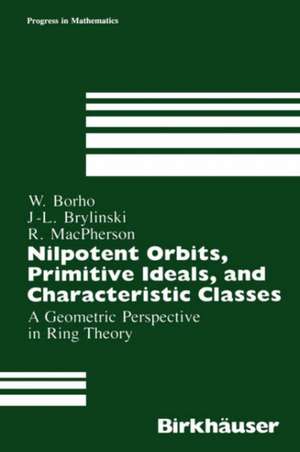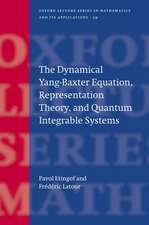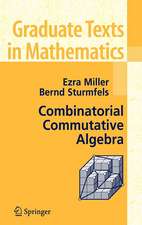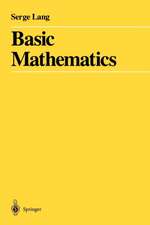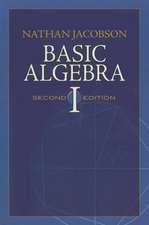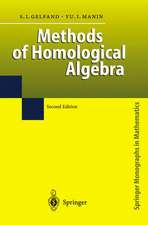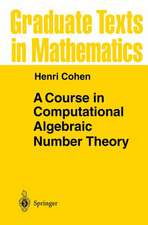Nilpotent Orbits, Primitive Ideals, and Characteristic Classes: A Geometric Perspective in Ring Theory: Progress in Mathematics, cartea 78
Autor Walter Borho, J.-L. Brylinski, R. MacPhersonen Limba Engleză Hardback – dec 1989
| Toate formatele și edițiile | Preț | Express |
|---|---|---|
| Paperback (1) | 379.68 lei 6-8 săpt. | |
| Birkhäuser Boston – 5 oct 2011 | 379.68 lei 6-8 săpt. | |
| Hardback (1) | 695.70 lei 6-8 săpt. | |
| Birkhäuser Boston – dec 1989 | 695.70 lei 6-8 săpt. |
Din seria Progress in Mathematics
- 24%
 Preț: 687.36 lei
Preț: 687.36 lei - 24%
 Preț: 740.80 lei
Preț: 740.80 lei - 9%
 Preț: 763.33 lei
Preț: 763.33 lei -
 Preț: 308.20 lei
Preț: 308.20 lei - 20%
 Preț: 695.88 lei
Preț: 695.88 lei -
 Preț: 362.51 lei
Preț: 362.51 lei -
 Preț: 308.13 lei
Preț: 308.13 lei - 18%
 Preț: 749.27 lei
Preț: 749.27 lei - 9%
 Preț: 766.42 lei
Preț: 766.42 lei - 20%
 Preț: 631.09 lei
Preț: 631.09 lei - 24%
 Preț: 638.88 lei
Preț: 638.88 lei - 15%
 Preț: 580.82 lei
Preț: 580.82 lei -
 Preț: 392.37 lei
Preț: 392.37 lei -
 Preț: 395.09 lei
Preț: 395.09 lei -
 Preț: 390.25 lei
Preț: 390.25 lei -
 Preț: 376.80 lei
Preț: 376.80 lei - 18%
 Preț: 729.53 lei
Preț: 729.53 lei - 15%
 Preț: 652.49 lei
Preț: 652.49 lei - 15%
 Preț: 649.22 lei
Preț: 649.22 lei - 18%
 Preț: 897.95 lei
Preț: 897.95 lei -
 Preț: 385.08 lei
Preț: 385.08 lei -
 Preț: 391.02 lei
Preț: 391.02 lei -
 Preț: 378.54 lei
Preț: 378.54 lei - 15%
 Preț: 531.59 lei
Preț: 531.59 lei - 15%
 Preț: 642.83 lei
Preț: 642.83 lei - 15%
 Preț: 650.69 lei
Preț: 650.69 lei -
 Preț: 381.21 lei
Preț: 381.21 lei -
 Preț: 392.37 lei
Preț: 392.37 lei -
 Preț: 398.53 lei
Preț: 398.53 lei - 15%
 Preț: 699.28 lei
Preț: 699.28 lei -
 Preț: 416.92 lei
Preț: 416.92 lei -
 Preț: 385.84 lei
Preț: 385.84 lei - 18%
 Preț: 902.65 lei
Preț: 902.65 lei - 18%
 Preț: 802.28 lei
Preț: 802.28 lei - 15%
 Preț: 640.06 lei
Preț: 640.06 lei - 18%
 Preț: 1129.83 lei
Preț: 1129.83 lei
Preț: 695.70 lei
Preț vechi: 818.46 lei
-15% Nou
Puncte Express: 1044
Preț estimativ în valută:
133.12€ • 145.06$ • 112.17£
133.12€ • 145.06$ • 112.17£
Carte tipărită la comandă
Livrare economică 24 aprilie-08 mai
Preluare comenzi: 021 569.72.76
Specificații
ISBN-13: 9780817634735
ISBN-10: 0817634738
Pagini: 134
Ilustrații: VIII, 134 p.
Dimensiuni: 155 x 235 x 10 mm
Greutate: 0.39 kg
Ediția:1989
Editura: Birkhäuser Boston
Colecția Birkhäuser
Seria Progress in Mathematics
Locul publicării:Boston, MA, United States
ISBN-10: 0817634738
Pagini: 134
Ilustrații: VIII, 134 p.
Dimensiuni: 155 x 235 x 10 mm
Greutate: 0.39 kg
Ediția:1989
Editura: Birkhäuser Boston
Colecția Birkhäuser
Seria Progress in Mathematics
Locul publicării:Boston, MA, United States
Public țintă
ResearchCuprins
General Introduction.- § 1. A Description of Springer’s Weyl Group Representations in Terms of Characteristic Classes of Cone Bundles.- 1.1 Segre classes of cone bundles.- 1.2 Characteristic class of a subvariety of a vector bundle.- 1.3 Characteristic class determined by a sheaf on a bundle.- 1.4 Comparison of the two definitions for Q.- 1.5 Homology of the flag variety.- 1.6 Cohomology of the flag variety.- 1.7 Orbital cone bundles on the flag variety.- 1.8 Realization of Springer’s Weyl group representation.- 1.9 Reformulation in terms of intersection homology.- 1.10 The Weyl group action.- 1.11 Reduction to a crucial lemma.- 1.12 Completion of the proof of theorem 1.8.- 1.13 Comparison with Springer’s original construction.- 1.14 Theorem: The maps in the diagram are W equivariant.- 1.15 Hotta’s transformation formulas.- § 2. Generalities on Equivariant K-Theory.- 2.1 Algebraic notion of fibre bundle.- 2.2 Equivariant vector bundles and definition of KG(X).- 2.3 Equivariant homogeneous vector bundles.- 2.4 Functoriality in the group G.- 2.5 Functoriality in the space X.- 2.6 The sheaf theoretical point of view.- 2.7 Existence of equivariant locally free resolutions.- 2.8 Remarks on Gysin homomorphisms in terms of coherent sheaves.- 2.9 Equivariant K-theory on a vector bundle: Basic restriction techniques.- 2.10 Filtrations on KG(X).- 2.11 Representation rings for example.- 2.12 Application of equivariant K-theory to D-modules.- § 3. Equivariant K-Theory of Torus Actions and Formal Characters.- 3.1 The completed representation ring of a torus.- 3.2 Formal characters of T-modules.- 3.3 Example.- 3.4 T-equivariant modules with highest weight.- 3.5 Projective and free cyclic highest weight modules.- 3.6 Formal characters of equivariant coherent sheaves.- 3.7Restriction to the zero point.- 3.8 Computation of ? degree.- 3.9 Character polynomials.- 3.10 Degree of character polynomial equals codimension of support.- 3.11 Positivity property of character polynomials.- 3.12 Division by a nonzero divisor.- 3.13 Proof of theorem 3.10 and 3.11.- 3.14 Determination of character polynomials by supports.- 3.15 The theory of Hilbert—Samuel polynomials as a special case.- 3.16 Restriction to one parameter subgroups.- 3.17 A lemma on the growth of coefficients of a power series.- 3.18 An alternative proof of theorem 3.10.- § 4. Equivariant Characteristic Classes of Orbital Cone Bundles.- 4.1 Borel pictures of the cohomology of a flag variety.- 4.2 Description in terms of harmonic polynomials on a Cartan subalgebra.- 4.3 Equivariant K—theory on T*X.- 4.4 Restriction to a fibre of T*X.- 4.5 Definition of equivariant characteristic classes.- 4.6 Comparison to the characteristic classes defined in §1.- 4.7 Equivariant characteristic classes of orbital cone bundles.- 4.8 Comparison with Joseph’s notion of “characteristic polynomials”.- 4.9 Generalization to the case of sheaves.- 4.10 Equivariance under a Levi subgroup.- 4.11 Multiple cross section of a unipotent action.- 4.12 For example SL2 equivariance.- 4.13 Completing the proof of theorem 4.7.2.- 4.14 Reproving Hotta’s transformation formula.- 4.15 On explicit computations of our characteristic classes.- 4.16 Example.- 4.17 Remark.- § 5. Primitive Ideals and Characteristic Classes.- 5.1 Characteristic class attached to a g module.- 5.2 Translation invariance.- 5.3 Characteristic variety of a Harish—Chandra bimodule.- 5.4 Homogeneous Harish-Chandra bimodules.- 5.5 Characteristic cycle and class of a Harish—Chandra bimodule.- 5.6 Identification with a characterpolynomial.- 5.7 Harmonicity of character polynomial.- 5.8 Equivariant characteristic class for a Harish—Chandra bimodule.- 5.9 Alternative proof of identification with character polynomials.- 5.10 Some non—commutative algebra.- 5.11 Definition of the polynomials PW.- 5.12 Relation to primitive ideals.- 5.13 Irreducibility of Joseph’s Weyl group representation.- 5.14 Irreducibility of associated varieties of primitive ideals.- 5.15 Evaluation of character polynomials.- 5.16 Computation of Goldie ranks.- 5.17 Joseph—King factorization of polynomials PW.- 5.18 Goldie ranks of primitive ideals.
Recenzii
"…Most of the results in this book are not new. Instead the aim has been to use geometric (in place of the more traditional algebraic) methods in the constructions and proofs. This sheds new lights on the close connection between the three topics. The book is not self-contained. It relies heavily on previous work by the authors as well as on many basic facts both from algebraic groups, topology and representation theory. However, the authors have taken great care to make the book readable to people without complete background in these theories..."
--Zentralblatt Math
--Zentralblatt Math
